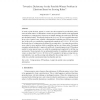85 search results - page 3 / 17 » The Complexity of Bribery in Elections |
IPL
2011
12 years 11 months ago
2011
We propose a probabilistic network model, called asynchronous bounded expected delay (ABE), which requires a known bound on the expected message delay. In ABE networks all asynchr...
JCSS
2010
13 years 6 months ago
2010
To make a joint decision, agents (or voters) are often required to provide their preferences as linear orders. To determine a winner, the given linear orders can be aggregated acc...
FSTTCS
2010
Springer
13 years 5 months ago
2010
Springer
Computing the Dodgson Score of a candidate in an election is a hard computational problem, which has been analyzed using classical and parameterized analysis. In this paper we reso...
AAAI
2010
13 years 5 months ago
2010
We consider the problem of manipulating elections via cloning candidates. In our model, a manipulator can replace each candidate c by one or more clones, i.e., new candidates that...
WDAG
2010
Springer
13 years 6 months ago
2010
Springer
Leader election and arbitrary pattern formation are fundammental tasks for a set of autonomous mobile robots. The former consists in distinguishing a unique robot, called the lead...

